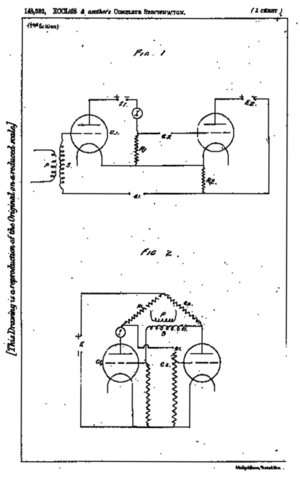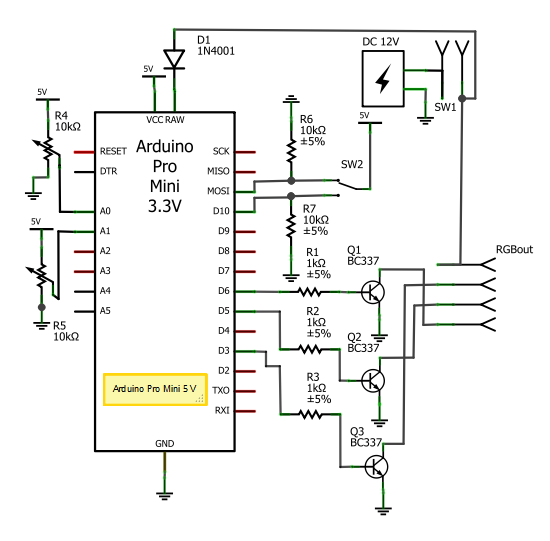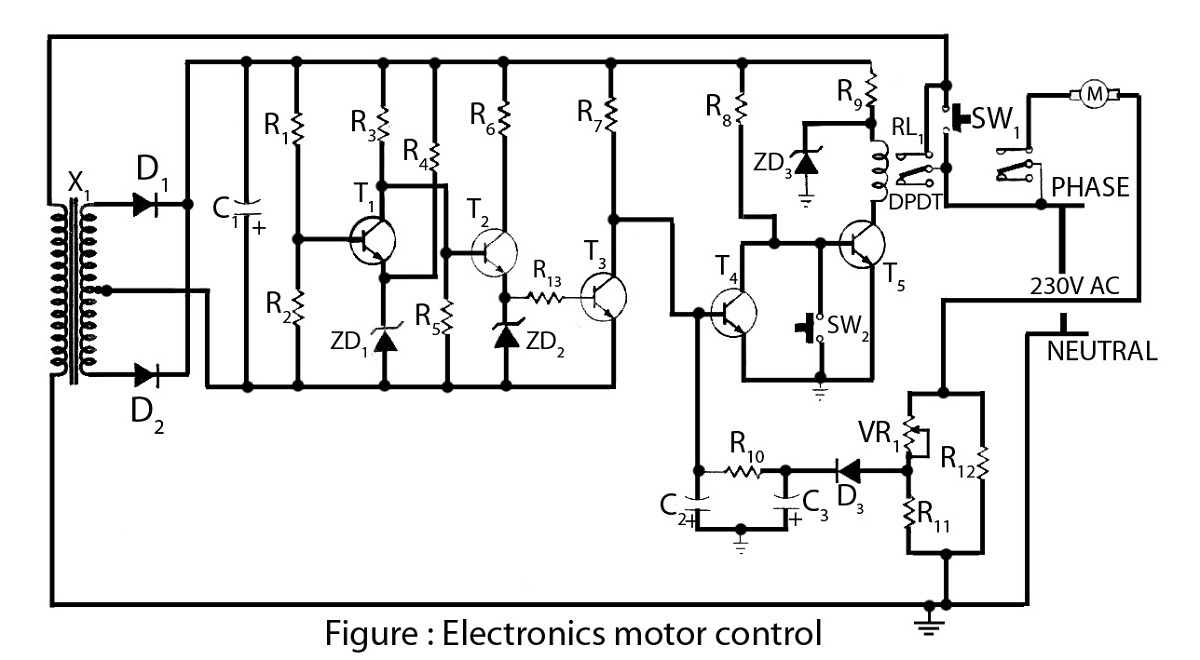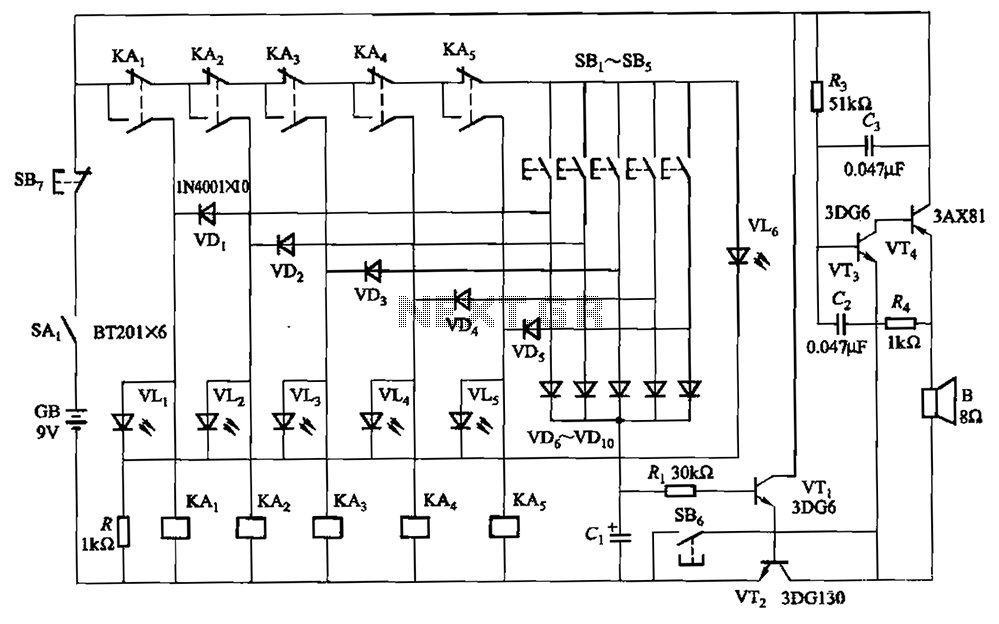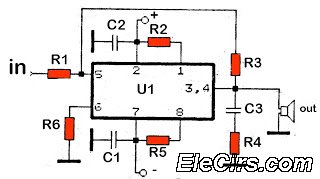
TALKING ELECTRONICS BEC
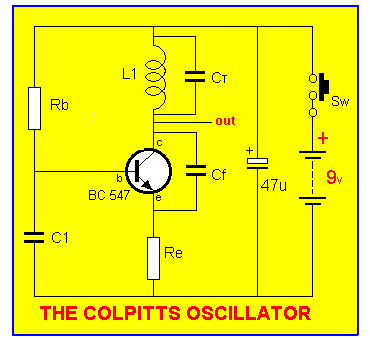
This circuit is easily identifiable by three equal-value capacitors and two equal-value resistors connected to the base of the transistor. The output signal of a transistor in COMMON EMITTER mode is FALLING when the input signal is RISING, which results in OUT OF PHASE signals. Directly connecting the output to the input to achieve oscillation is not feasible, as the rising output would feed back into the base, turning the transistor ON and subsequently reducing the output. A short delay is required to allow the output voltage to rise before the transistor can be turned ON to decrease the output voltage. This delay is accomplished through a configuration of capacitors and resistors at the base. Capacitors inherently take time to charge, a characteristic leveraged in the PHASE-SHIFT OSCILLATOR circuit. The values of the components establish a time-delay, determining the operational frequency of the circuit. However, the arrangement is more intricate than a simple "time-delay" setup, as each capacitor performs distinct functions throughout the cycle. Notably, the feedback signal only needs to be about 1/50th of the collector signal for the circuit to function, given that the transistor's gain ranges from 50 to 100. This allows for significant ATTENUATION in the signal while maintaining circuit operation. The 1M resistor struggles to change the base voltage quickly due to the substantial "holding effect" of the 22n capacitor on the signal. This voltage is transferred to the three uncharged capacitors, which quickly raise the base voltage to turn the transistor ON. A critical aspect of the circuit's operation is the voltage across the second 10k resistor, which initially measures 0.7V and decreases slightly as the first capacitor charges, thereby moderating the "hard turn-on" of the transistor. Consequently, the collector voltage rises gradually; as the charge on the first two capacitors builds, the charging current diminishes, leading to a reduction in voltage across the second 10k resistor. This voltage drop is conveyed to the base of the transistor through the third 22n capacitor, causing the transistor to turn off slightly. The 1M base-bias resistor then engages, turning the transistor ON and causing the collector voltage to drop. This "falling effect" is relayed to the base via the three capacitors, resulting in a slight turn-off of the transistor. The 1M resistor subsequently charges the 22n capacitor, which regulates the rate at which the transistor turns off. The circuit's operation is considerably more complex than typically described in textbooks, necessitating a thorough understanding of the process to interpret waveforms observed on a CRO accurately. The output voltage of the Phase Shift Oscillator exhibits rising and falling patterns, which generate a sine wave, as illustrated in the accompanying diagram. Another circuit capable of producing a sine wave is the Colpitts Oscillator, characterized by a small capacitor tapping the TUNED CIRCUIT to monitor the waveform. The Colpitts Oscillator consists of a tuned circuit formed by inductor L1 and capacitor CT (often referred to as the tuning capacitor) in conjunction with a transistor in common-base mode. At the circuit's operating frequency, capacitor C1 at the transistor's base prevents fluctuations in the base voltage, thus maintaining the common-base configuration. The emitter resistor Re ensures that the emitter remains above the 0V rail, allowing for injection via capacitor Cf (the feedback capacitor) to sustain oscillator operation. This illustrates a remarkable effect arising from two seemingly simple components.This circuit is easy to recognise by the three equal-value capacitors and two equal-value resistors connected to the base of the transistor. We have already mentioned the signal at the output of a transistor connected in COMMON EMITTER mode is FALLING when the signal at the input is RISING.
This is called OUT OF PHASE signals and you cannot connec t the output directly to the input to get the transistor to oscillate. If you do, the rising output will be fed into the base to turn the transistor ON and this will reduce the output. The signal has to be delayed by a short period of time to allow the output voltage to rise and then the transistor can be turned ON to reduce the voltage on the output.
This delay is created by a set of capacitors and resistors on the base. We have already mentioned the fact that a capacitor takes a period of time to charge and this feature is utilized in the PHASE-SHIFT OSCILLATOR circuit. The value of the components create a time-delay and this sets the frequency at which the circuit operates.
But it`s a bit more complex than a single "time-delay" arrangement. Each capacitor is doing something different at each part of the cycle. The interesting point to note is the feedback signal only has to be about 1/50th of the collector signal for the circuit to operate as the gain of the transistor is about 50 to 100. This means there can be a lot of ATTENUATION (reduction) in the signal and the circuit will still operate.
The signal through the 1M finds it difficult to pull the base up or down "quickly" because the 22n capacitor has a very large "holding effect" on the signal. This voltage is passed to the three uncharged capacitors and they pull the base up very quickly to turn the transistor ON.
The secret to the operation of the circuit is the voltage across the second 10k resistor. During this time the voltage across it is 0. 7v and this reduces slightly as the first capacitor charges, so that the "hard turn-on" of the transistor is reduced. The collector voltage is allowed to gradually rise and as the charge on the first two capacitors increases, the charging current reduces and this means the voltage across the second 10k resistor reduces.
This reduction in voltage is passed to the base of the transistor via the 3rd 22n capacitor and the transistor turns off a little. The 1M base-bias resistor now comes into operation by turning the transistor ON and the collector voltage falls.
The "falling effect" is passed directly to the base via the three capacitors with the result that they turn the transistor off slightly. The 1M takes over by charging the 22n and this controls the rate at which the transistor turns off. As you can see, the operation of the circuit is much more complex than explained in any text book and its important to know exactly what is happening so that when you look at the waveform on a CRO, you understand how the waveforms are produced.
The animation above showsthe output voltage of the Phase shift oscillator is rising and falling. We have already seen a rising and falling voltage produces a sinewave as shown in the diagram opposite. This is how a rising and falling voltage produces a sinewave. Another circuit that produces a sinewave is the Colpitts Oscillator. It is recognised by a small capacitor tapping the TUNED CIRCUIT to monitor the waveform. The colpitts oscillator consists of a tuned circuit made up of inductor L1 and capacitor CT (sometimes called the tuning capacitor) and a transistor in common-base mode.
At the frequency of operation for the circuit, the capacitor C1 on the base of the transistor prevents the base moving (rising and falling) and this puts it in the common-base configuration. Re is the emitter resistor and keeps the emitter from the 0v rail so the emitter can be injected via capacitor Cf (the feedback capacitor) to keep the oscillator operating.
This is an amazing effect for two seemingly simple com 🔗 External reference
This is called OUT OF PHASE signals and you cannot connec t the output directly to the input to get the transistor to oscillate. If you do, the rising output will be fed into the base to turn the transistor ON and this will reduce the output. The signal has to be delayed by a short period of time to allow the output voltage to rise and then the transistor can be turned ON to reduce the voltage on the output.
This delay is created by a set of capacitors and resistors on the base. We have already mentioned the fact that a capacitor takes a period of time to charge and this feature is utilized in the PHASE-SHIFT OSCILLATOR circuit. The value of the components create a time-delay and this sets the frequency at which the circuit operates.
But it`s a bit more complex than a single "time-delay" arrangement. Each capacitor is doing something different at each part of the cycle. The interesting point to note is the feedback signal only has to be about 1/50th of the collector signal for the circuit to operate as the gain of the transistor is about 50 to 100. This means there can be a lot of ATTENUATION (reduction) in the signal and the circuit will still operate.
The signal through the 1M finds it difficult to pull the base up or down "quickly" because the 22n capacitor has a very large "holding effect" on the signal. This voltage is passed to the three uncharged capacitors and they pull the base up very quickly to turn the transistor ON.
The secret to the operation of the circuit is the voltage across the second 10k resistor. During this time the voltage across it is 0. 7v and this reduces slightly as the first capacitor charges, so that the "hard turn-on" of the transistor is reduced. The collector voltage is allowed to gradually rise and as the charge on the first two capacitors increases, the charging current reduces and this means the voltage across the second 10k resistor reduces.
This reduction in voltage is passed to the base of the transistor via the 3rd 22n capacitor and the transistor turns off a little. The 1M base-bias resistor now comes into operation by turning the transistor ON and the collector voltage falls.
The "falling effect" is passed directly to the base via the three capacitors with the result that they turn the transistor off slightly. The 1M takes over by charging the 22n and this controls the rate at which the transistor turns off. As you can see, the operation of the circuit is much more complex than explained in any text book and its important to know exactly what is happening so that when you look at the waveform on a CRO, you understand how the waveforms are produced.
The animation above showsthe output voltage of the Phase shift oscillator is rising and falling. We have already seen a rising and falling voltage produces a sinewave as shown in the diagram opposite. This is how a rising and falling voltage produces a sinewave. Another circuit that produces a sinewave is the Colpitts Oscillator. It is recognised by a small capacitor tapping the TUNED CIRCUIT to monitor the waveform. The colpitts oscillator consists of a tuned circuit made up of inductor L1 and capacitor CT (sometimes called the tuning capacitor) and a transistor in common-base mode.
At the frequency of operation for the circuit, the capacitor C1 on the base of the transistor prevents the base moving (rising and falling) and this puts it in the common-base configuration. Re is the emitter resistor and keeps the emitter from the 0v rail so the emitter can be injected via capacitor Cf (the feedback capacitor) to keep the oscillator operating.
This is an amazing effect for two seemingly simple com 🔗 External reference
